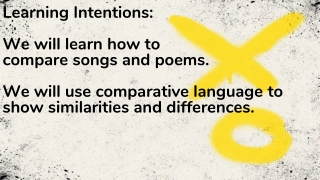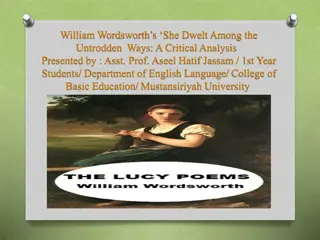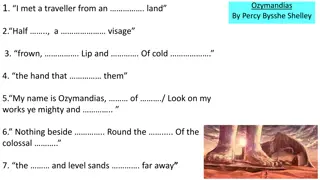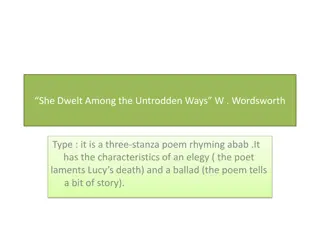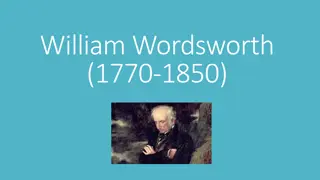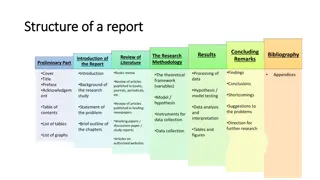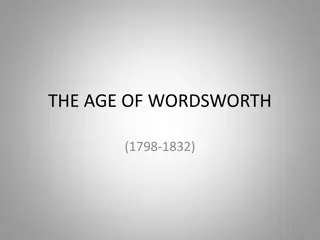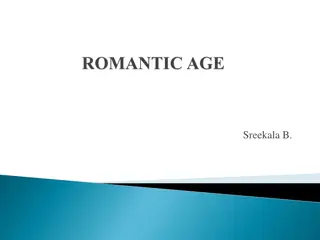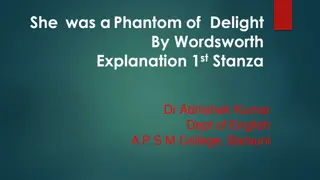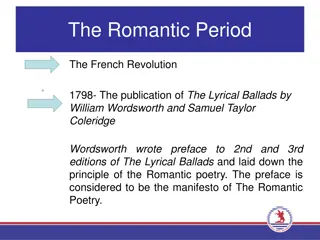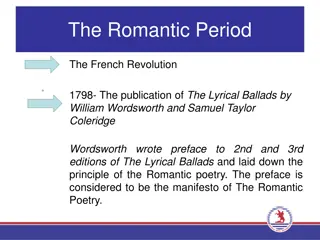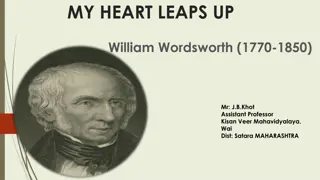Analysis of Wordsworth's Preface to Lyrical Ballads
William Wordsworth's Preface to Lyrical Ballads serves as a manifesto for the Romantic movement, emphasizing the use of common language and the expression of emotion in poetry. Wordsworth defines poetry as the spontaneous overflow of powerful feelings, rooted in contemplation rather than mere spontaneity. He outlines the poet's process, highlighting the importance of observation, recollection, and the creative exploration of everyday life.
Uploaded on Sep 20, 2024 | 1 Views
Download Presentation

Please find below an Image/Link to download the presentation.
The content on the website is provided AS IS for your information and personal use only. It may not be sold, licensed, or shared on other websites without obtaining consent from the author.If you encounter any issues during the download, it is possible that the publisher has removed the file from their server.
You are allowed to download the files provided on this website for personal or commercial use, subject to the condition that they are used lawfully. All files are the property of their respective owners.
The content on the website is provided AS IS for your information and personal use only. It may not be sold, licensed, or shared on other websites without obtaining consent from the author.
E N D
Presentation Transcript
I.B. P.G.COLLEGE PANIPAT CLASS : M.A. (ENG) FINAL YR. UNIT : PREFACE TO LYRICAL BALLADS TOPIC : THEORY OF POETRY
PRESENTED BY PREETI PAL ASSISTANT PROFESSOR ENGLISH DEPARTMENT
PREFACE TO THE LYRICAL BALLADS The preface to the Lyrical Ballads is an essay, composed by William Wordsworth, for the second edition of the poetry collection Lyrical Ballads, and then greatly expanded in the third edition of 1802. It has come to be seen as a de facto manifesto of the Romantic movement. The four guidelines of the manifesto include: Ordinary life is the best subject for poetry Wordsworth uses common man's language. Everyday language is best suited for poetry Expression of feeling is more important than action or plot "Poetry is the spontaneous overflow of emotion" that "takes its origin from emotion, recollected in tranquility."
SUMMARY OF PREFACE TO LYRICAL BALLADS Preface to Lyrical Ballads by William Wordsworth begins with a discussion of the collection of poems, written mostly by Wordsworth with contributions by S.T. Coleridge. Originally published in 1798, in 1800, Wordsworth added an earlier version of the Preface, which he extended two years later. Because he felt his poems were of a new theme and style, Wordsworth felt they needed an introduction. Some scholars say that Coleridge wanted to write the preface, but never got around to it, so the work fell to Wordsworth instead. As the majority of the poems in the collection are by Wordsworth, this was probably a more appropriate choice, though there is suggestion in some of Coleridge s later writings that the two disagreed about what the Preface should say. In the Preface, Wordsworth writes that the purpose of the collection was to write poems that dealt with things that happen in everyday life. Most importantly, Wordsworth considered each poem in the collection to be an experiment in language usage, or diction. He wanted to find out if conversational language could be used effectively in poetry.
What, then, is poetry? Wordsworth sets out to define this particular form of art. In the Preface to Lyrical Ballads, Wordsworth outlines his definition of the nature and function of poetry as well as identifying the qualities that make someone a true poet. For Wordsworth, poetry must reflect spontaneity and an overflow of powerful feelings. Passion is key, as are mood and temperament. Although poetry must emerge from spontaneity, it must not be written spontaneously. Rather, Wordsworth asserts that a poem should be the result of long and deep reflection. He also cautions against being too concerned with the poetic rules of Classicism.
Next, Wordsworth breaks down the poets process into four stages. The first is observation. A person, object, or situation must stimulate powerful emotions in the Romantic poet, and those observations must be noted. Recollection follows, which is the stage when the poet contemplates those observations. For this, tranquility is a must. Memories may surface that are days old or older, and the poet should contemplate those memories to explore how the emotions they provoke relate to past experiences. The third stage is filtering, when the poet clears the mind of all non-essential elements. The result of this is that the poet s personal experience becomes relevant to a wider audience. It s not until the fourth and final stage that the poet should begin to compose. The goal is to express emotions in a way that the reader will understand, and can therefore contemplate.
Wordsworths next topic is imagination. He begins by discussing how the neo- classicists defined imagination. They said that the mind was passive, and recorded sensations. Imagination, therefore, is a function of memory combined with the ability to associate those sensations with other things that may or may not exist. He provides the example of mythical creatures, which elicit, in literature, real sensations. For Romantics like Wordsworth, imagination is much more creative. Rather than assigning recorded sensations to other objects, the imagination has the power to create a new reality, and to see beyond the material world surrounding the poet. As for what to write about, Wordsworth states that poetry can capture any and every subject that is of interest to the mind. What matters is not whether a subject is poetic, but rather, whether the poet can add meaning to a subject and therefore make it poetic. Suddenly, themes from common life can be poetic and worthy of the contemplation Wordsworth requires of the poet. The reason this works, according to his argument, is that those who live a rustic lifestyle are closer to nature and therefore farther away from vanity bred by artifice.
Next, Wordsworth dives deeper into the function of poetry. Unlike the classicists, who value art for the sake of art the idea that art should be produced regardless of any moral values or concerns Wordsworth and the Romantics believe in art for the sake of life. That is, Wordsworth sees the function of poetry as ennobling the reader through the teaching of moral and philosophical values and ideals.
Finally, Wordsworth discusses in greater depth the diction of poetry. Diction is basically the use of language, but more specifically, it s the choice of words, phrases, sentence structures, and even figurative language. While diction is important in all of literature, Wordsworth places particular importance on its role in poetry because it is the poet s medium. Whereas prose also has characters, setting, and plot to convey a message, the poet s choice of language, or diction, is the sole means of expression in poetry. Despite this, Wordsworth argues that the diction of poetry and prose is the same, and criticizes the neo- classicists for their artificial and unnatural language. Passion should drive diction, not ornament, dignity or meter. He wants poetry to center on rustic, humble situations using rustic, humble language. According to Wordsworth, that is the real source of poetic truth and beauty.



